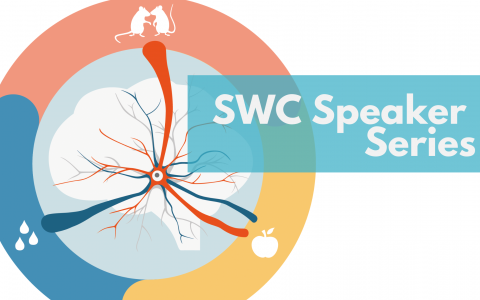
Studying social behaviours at a cellular level
An interview with Dr Ziv Williams, Harvard University, conducted by April Cashin-Garbutt
Social interactions are complex. They involve many different elements, which makes them challenging to study, particularly at a cellular level. In a recent SWC Seminar, Dr Ziv Williams explained how he is overcoming these challenges using naturalistic approaches. In this Q&A, he shares his most interesting findings to date and his drive to build a comprehensive map of how neurons in the brain encode language.
Why is it challenging to understand the basic cellular processes that underlie social behaviour and how individuals communicate?
Social behaviour is a very interesting topic, but it is hard to dissect at the level of an individual neuron. Social interactions are high dimensional, which means there are many elements involved in real-time, dynamical, interactive social behaviour. In many situations there is also no right or wrong answer. This makes it more difficult to study than in more traditional studies, such as those involved in studying vision or motoric behaviour.
A lot of times social interactions involve trying to anticipate what somebody else is thinking, which is also innately unobservable and unknown. Being able to mutually favourably interact socially is a complex challenge because what is good for one person is not always good for the other, and what’s mutually good for both people can sometimes be different from what’s individually good for each person.
In humans, social interactions often use language, which is complex. There are so many elements to how words are formed and put together. Even someone’s tone can denote their emotion, or how they emphasise certain words can affect meaning. In addition, there are facial features, for example is someone smiling or not when they are speaking. Previous interactions are also important – how someone interacted previously can affect current interactions. Moreover, oftentimes it is not just two individuals interacting but there are many individuals within the group. Everyone has their own preferences and dominance relationships within a group.
How are you overcoming these challenges using naturalistic approaches?
We try to boil the questions down into parts that are amenable to neuronal analysis. The first study I talked about in the SWC seminar involved autism spectrum disorder and its relation to the SHANK3 gene. In this study, we tried to understand very basic elements such as is something happening to me or to somebody else? We also varied other elements, such as whether an experience was positive or negative. In primates, on the other hand, we can use more complex tasks such as those involved when groups of individuals interact.
More recently, we have also been examining language where you have to use more advanced techniques. For example, there are computational ways of quantifying words, how similar they are and what their meanings are. You can use dimensionality reduction approaches to try to distil high-level information into something that’s simpler. You can then ask whether a particular cell changes its activity only when one hears, for example, about animate or inanimate objects, or animals versus all other types of semantic categories.
What have been your most interesting findings so far?
My work spans different fields from animals to humans. In the animal domain, it has been interesting to be able to find neurons that encode some of the core components of social behaviour, such as the identity of other individuals. When you look at these cells as a collective, we can also paint a rich map of interactions between individuals, such as who did what to whom.
We’ve also been looking at how genetic conditions and their association with autism spectrum disorder (ASD) interrelate. To a certain degree, we have been able to show that it is possible to reverse certain features of ASD in a mouse model, even in adults. This may have some therapeutic implications.
The most fun part for me has been looking at language because we use it all the time but relatively little is known about its cellular underpinnings. We have been able to start defining the basic neuronal building blocks by which language is processed in the brain.
Did you find any of the cellular mechanisms for interactive social behaviour particularly surprising?
The two most surprising things that we’ve found so far is one that it is possible to restore normal social behaviour and neuronal encoding in an animal model of ASD. Traditionally, developmental conditions like ASD have been viewed as set in stone. It was striking to find that you can restore relatively normal neuronal function and that the way brain cells encode social information can be modified and restored.
The second most surprising finding is that there appear to be fairly well-defined neurons in the brain that are finely tuned to encode particular aspects of language. We found that certain cells encode, very specifically meanings. For example, certain neurons respond uniquely to animals but not much else. Other neurons respond to emotional states like the words happy, sad, angry, but very little else.
There are also neurons that respond to particular syntactic relationships. For example, is this the subject or object of a sentence, or does this word perform a particular function like being an adjective or a verb. It is interesting to find these building blocks that, when you glue them together, allow you decipher elements that make up words or sentences. To find neurons that are tuned to these elements is very exciting.
What are the main clinical implications of your research?
The hope is that if you can show in a mouse model that you can restore genetic expression locally, it may be possible to do this in humans as well. A lot of social behaviour is core to many conditions including depression, schizophrenia, autism and also normal interactive social behaviour. It is really ubiquitous. And so, by understanding social behaviour better, the hope is to be able to treat conditions in which it is disrupted.
Have you studied animals that are naturally less social?
Within wild type animals there is a lot of variability, some animals are much more social than others. At one extreme, you have individuals that are extremely non-social, but you also have individuals that are hypersocial such as in Williams syndrome. I’ve always been very curious about what drives this, and it is one of the things we are looking at.
There are some animal species that are highly social. For example, mice are very social animals. Then you have other species, such as some felines, that tend to spend their time alone. What drive these differences is an interesting question.
What’s the next piece of the puzzle your research is going to focus on?
We’re starting to build a comprehensive framework and map how neurons in the brain encode different elements of language. It starts from basic phonetic elements, the articulatory movements that you make to produce the word sounds to how different parts of your mouth move to produce consonants or vowels. We’d also like to try to understand how neurons represent certain meanings, and their semantic representations.
More recently we’ve also been using natural language processing models, like ChatGPT. There are other GPT models and other models like BERT and LSTM, that let you capture the higher-level components of language. We are trying to study those elements at a basic cellular level.
How do you hope your research will impact the field in terms of the use of naturalistic approaches?
I think one of the important things to study is not just how the brain represents very distilled aspects of behaviour, such as one sensory stimulus, but to capture the way we naturalistically interact within the environment or with each other.
I think that by looking at how the brain behaves under naturalistic settings it will be possible to build a more comprehensive understanding of how the brain functions. Many individuals within natural environments or within the wild, for example, interact within large, complex, social groups, not just pairs of individuals. Many of these interactions involve different components like past behaviour, real-time dynamical interactions, body positions, odours and so forth. Studying these may therefore allow us to capture the full spectrum of how the brain really processes these behaviours.

About Dr Williams
Dr Williams is associate professor in neurosurgery at Harvard Medical School, Massachusetts General Hospital and Faculty at Harvard Medical School Program in Neuroscience and at the Harvard-MIT program in Health Science and Technology. His interests focus on animal and human neurophysiology on topics ranging from interactive social behaviour in mice and primates to decision making and language in humans. He also performs surgical procedures that focus on functional and reconstructive neurosurgery and teaches on topics in epilepsy, spine and peripheral nerve surgery. He has authored publications on these topics in Nature, Science, Cell and Nature Neuroscience among others and is supported by the NIH.

